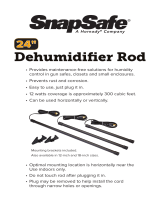
506794-01PPage 10 of 16 Issue 1243
Electrical Wiring
All wiring must conform to the National Electrical Code, the
Canadian Electrical Code, and any local codes. Connect
the 115-volt, single phase service to the unit at the
junction box. Use a separate fused branch electrical circuit
containing a properly sized fuse or circuit breaker. Run this
circuit directly from the main switch box to an electrical
disconnect that is readily accessible and located near the
furnace. Follow carefully the wiring diagrams adhered to
the inside of the blower compartment door.
The electrical supply to the mechanical vent system
must be supplied from the appliance. All wiring must be
appropriate Class I wiring. Wiring must be installed in rigid
metal conduit, intermediate metal, or be otherwise suitably
protected from physical damage. Refer to the wiring
diagrams supplied with the venter kit for proper electrical
connections.
Thermostat
Locate the thermostat on an inside wall in a room usually
occupied during the day, such as a living room or dining
room, at a height of 4-1/2” from the oor. Avoid direct
sunlight or supply air from a register. Make sure the location
is not adjacent to appliances such as ovens or lights. Wire
the thermostat with minimum of #18 AWG thermostat wire.
Continuous Blower Operation
The comfort level of the living space can be enhanced
when using this feature by allowing continuous circulation
of air between calls for cooling or heating. The circulation
of air occurs at half the full cooling airow rate. This can
produce more even temperatures throughout the home
and/or continuous operation of IAQ accessories.
Oil Supply and Oil Filter Connection
Continuous lengths of heavy wall copper tubing or steel
pipe are recommended and should be installed under the
oor or near walls to protect from damage. Do not run lines
on oor joists or other reverberating surfaces. Always use
are ttings located in accessible places.
Install a generous capacity oil lter inside building between
the fuel shuto valve and burner. Locate lter and valve
close to burner for easy servicing. An oil lter is required
for all models. A 100-micron lter is recommended.
Combustion Chamber
The combustion chamber is installed in the furnace at the
factory. Read the instruction plate on the front of the unit
concerning proper care of the chamber.
This combustion chamber is made of preformed ceramic
ber material. Use extreme care when installing the oil
burner so that the chamber is not damaged around the
burner tube.
To enable the continuous blower operation, place the fan
switch on the thermostat into the ON position. A call for fan
from the thermostat closes R to G on the blower interface
board. The control waits for a 1-second thermostat
debounce delay before responding to the call for fan by
ramping the circulating blower up to 50% of the cooling
speed. When the call for continuous fan is satised, the
control immediately ramps down the circulating blower.
Humidier
A humidier can be installed with this furnace. Terminals
are provided on the control board, which sustains a 120-
volt output to operate a humidier. The “HUM” terminal is
energized whenever the thermostat calls for heat. Refer to
furnace wiring diagram for specic connection information.
Electronic Air Cleaner
An electronic air cleaner can be installed with this furnace.
Terminals are provided on the control board for connection
of a 120-volt electronic air cleaner. The “EAC” terminal is
energized whenever the thermostat calls for heat, cooling,
or continuous blower. Refer to the furnace wiring diagram
for specic connection information.
Variable Speed Features
This furnace is equipped with a variable speed circulation
air blower motor that will deliver a constant airow within a
wide range of external static pressures. Other features of
this variable speed motor include:
Blower Ramp Up
The variable speed motor will slowly ramp up to normal
operating speed. This minimizes sound and increases
comfort by eliminating the initial blasts of air encountered
with standard blower motors.
Blower Ramp Down
At the end of a cooling or heating cycle, the variable
speed motor will slowly ramp down. If continuous blower
operation has been selected, the variable speed motor will
slowly ramp down to 50% of the selected cooling CFM.
Passive and Active Dehumidication
For situations where humidity control is a problem, a
dehumidication feature has been built into the variable
speed motor. At the start of each cooling cycle, the variable
speed motor will run at 82% of the rated airow for 7.5
minutes. After 7.5 minutes has elapsed, the motor will
increase to 100% of the rated airow.
To achieve additional dehumidication, remove the
dehumidify jumper located at the bottom right of the blower
interface board (see Table 1) and connect a humidity control
that opens on humidity rise to the HUM and R terminals.
The HUM terminal on the blower interface board must be
connected to the normally closed contact of the humidity
control so that the board senses an open circuit on high
















